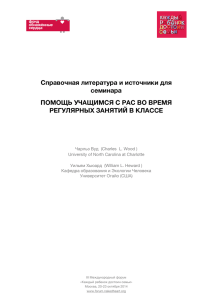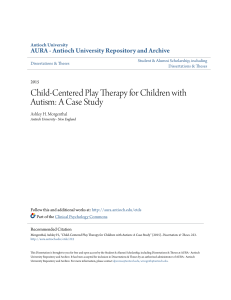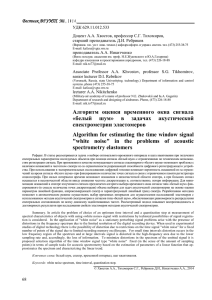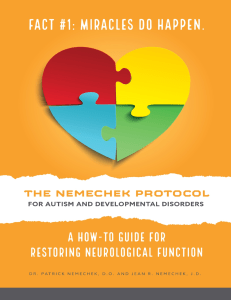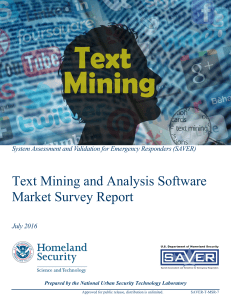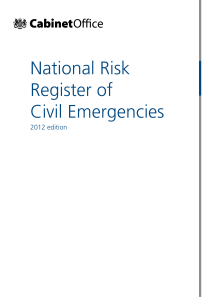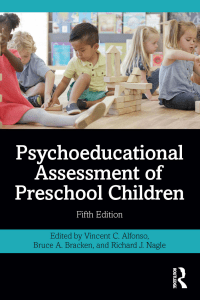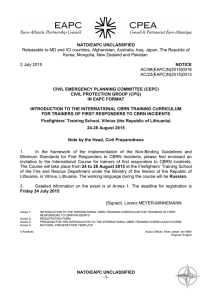ALERT Presentation with tags
реклама
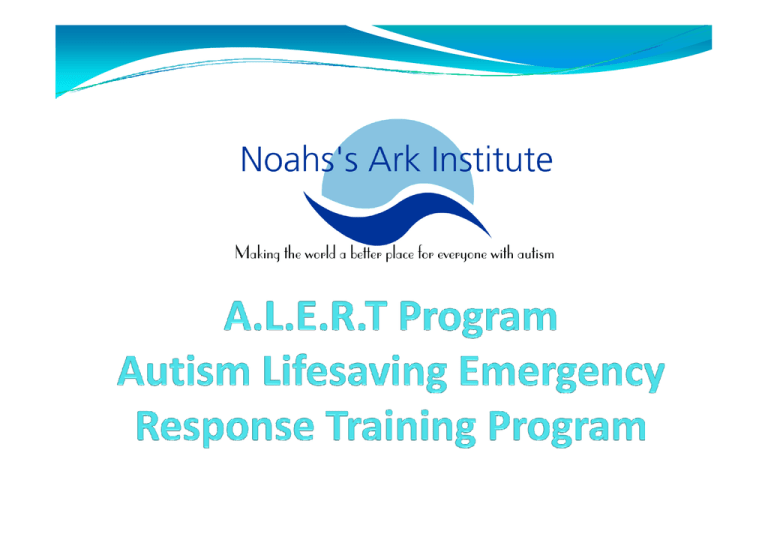
Autism is Prevalent The prevalence of autism in the United States is 1 in 110, according to the CDC's Autism and Developmental Disabilities Monitoring Network in 2009 New data is putting the prevalence rate at closer to 2% of the population The US population is about 306 million, which translates to roughly 6 million diagnosed Autistic people in the US. Individuals with autism and other developmental disabilities will interact with first responders at a higher rate of incidence than non disabled individuals [email protected] 973.619.0963 noahsarkinstitute.org “As the author of legislation pending in Congress to reauthorize important programs in the Department of Health and Human Services on autism and other developmental disabilities, I am very aware of the tremendous benefit of sharing what have been demonstrated to be the most effective practices for providing services and interventions to individuals with developmental disabilities and their families. It is heartening to know that FEMA and its partners are committed to educating the emergency management community and the public on practices to more effectively meet the needs of the disabled during emergencies.” Congressman Chris Smith (R-New Jersey) 2011 [email protected] 973.619.0963 noahsarkinstitute.org Autism is Prevalent New Jersey New Jersey has a prevalence rate which is one of the highest in the nation. 1 in 94 eight year olds in the state have been diagnosed with an ASD (Autism Spectrum Disorder) 1 From early diagnosis and intervention programs specifically designed to meet the needs of the autism population, the opportunity for many individuals to fully participate in community life has increased exponentially 1CDC Morbidity and Mortality Weekly Report; February 9, 2007; 56(SS-1); 1-11 Rice C [email protected] 973.619.0963 noahsarkinstitute.org Legislative Timeline 2000, Children’s Health Act created Interagency Autism Coordinating Council (IACC) 2001, Chris Smith (R-NJ) co-founded with Mike Doyle (D- PA) the Congressional Autism Caucus which is “committed to improving research, education, and support services for person with autism 2001 National Research Council Published Educating Children with Autism 2003 first Autism Summit in Washington DC. 2003 TEACH ACT introduced in the HR and Senate to provide assistance to teachers of children with autism. [email protected] 973.619.0963 noahsarkinstitute.org Timetable Continued 2006 Combating Autism Act through FY 2011 Up for reauthorization now! 2007 Expanding the Promise of Individuals with Autism Act Sponsor: Sen. Hillary Clinton [D-NY]This bill never became law. A bill to improve support and services for individuals with autism and their families. 2008 Helping HANDS for Autism Act Sponsor: Sen. Robert Menéndez [D-NJ] This bill never became law. A bill to increase housing, awareness, and navigation demonstration services (HANDS) for individuals with autism spectrum disorders. IACC replaced 2003 plan with 2009 Strategic Plan for Autism Research www.iacc.hhs.gov 2011 Global autism Sponsor: Rep. Christopher Smith [R-NJ4] To establish a health and education grant program related to autism spectrum disorders, and for other purposes. [email protected] 973.619.0963 noahsarkinstitute.org New Jersey Acts Why New Jersey NJ reputation for quality services Very high prevalence 7 bill autism package in 2007 Registry, first responders, Gov. council activities, Healthcare provider information, Asperger's pilot, Adults with ASD task force Insurance legislation signed in 2009 [email protected] 973.619.0963 noahsarkinstitute.org Training for First Responders P.L. 2008, C.80 Under this law new ENTs, volunteers and paid firefighters and local police officer recruits are required to complete the training as a condition of certification. First responders currently licensed in New Jersey are now required to complete the training as a continuing education course within three years of law passage. DHSS was required to establish a training program for first responders on DD This course is required training for all EMTs and Paramedics Official DHSS curriculum roll-out was at the end of 2009 First Responders must take a proactive approach in learning how to recognize and work with individuals on the autism spectrum, to better provide for their welfare and safety [email protected] 973.619.0963 noahsarkinstitute.org Autism Defined: a neurodevelopmental disability that typically appears during the first three years of life caused by a complex interaction between genetic and environmental factors. It affects a person's ability to communicate and interact socially with others associated with repetitive behaviors and interests [email protected] 973.619.0963 noahsarkinstitute.org If Autism is a Neurodevelopmental Disability: What is Neurodevelopment? Simply how the neurological systems are developing or have developed When there are problems with the CNS (Central Nervous System, PNS (Peripheral Nervous System, ANS (Autonomic Nervous System) there may be a neurodevelopmental disability which may be identified by the neurologist or other specialists with the knowledge and expertise to make this type of diagnosis [email protected] 973.619.0963 noahsarkinstitute.org Dimensions of autism1 • • • • • Behaviourally defined Endpoint of several organic etiologies Disturbances in social relatedness Impairments in communication and play Presence of restricted, circumscribed interests and repetitive behaviours Communication/ language impairments Autism Behavioral Rigidity DSM-IV TR. Washington, DC: American Psychiatric Association; 2000. p70-75. Tuchman R. Neurol Clin. 2003;21:915-32,vii. p917, A. [email protected] 973.619.0963 noahsarkinstitute.org Social Deficits A.L.E.R.T. Autism Lifesaving Emergency Response Training Program This seminar is designed for first responders and the allied professionals who may come into direct contact with individuals on the autism spectrum. Continuing Education Units 3.0 contact hours [email protected] 973.619.0963 noahsarkinstitute.org Learning objectives Attendees will: Overview Autism Spectrum Disorders (ASD) Distinguish between autism, high functioning autism, PDD-NOS and Asperser's Syndrome. Review Co-occurring conditions Discuss clinical presentations Review Prevalence [email protected] 973.619.0963 noahsarkinstitute.org Tools For The Toolkit Proactive response Contact scenarios Behavioral presentations Receptive vs. expressive language abilities Modifications for first responders Outreach opportunities [email protected] 973.619.0963 noahsarkinstitute.org Benefits This seminar is designed to provide information about the definition and characteristics of ASD as well as ideas, strategies, models and interventions that will lay the groundwork for integrated, comprehensive, proactive services which maximize the potential of a positive encounter between first responders and the autism community. Greatly mitigate adverse situations caused by the lack of understanding in communicating and gathering vital information. [email protected] 973.619.0963 noahsarkinstitute.org Trained thus far Over 3000 trained first responders inclusive of police, firefighters and EMTs both volunteer and paid teams Face to face program gives participants the opportunity to ask questions, address concerns, role play as needed [email protected] 973.619.0963 noahsarkinstitute.org Pre/ Post Test Test what you know about autism 1. Name two of the three core domains considered in a diagnosis of autism? Communication / Language impairments/ Social deficits 2. Name two observable “presentations” for autism. Anxiety, and self stimulatory behavior, repetitive speech, non verbal, lack of eye contact, avoidance of directions 3. Name one possible co-occurring diagnosis that may be present with autism. ADHD, Epilepsy, Genetic Syndrome, MR 4. What is the prevalence of autism in New Jersey? 1 in 94 5. Name one reason why elopement is such a serious threat to individuals with autism. Attracted to water, no fear response [email protected] 973.619.0963 noahsarkinstitute.org 6. In ASD, receptive skills are generally better than expressive skills. State two modifications you may use to increase the likelihood of being understood. Slow down language and allow extra time to process information 7. Define self stimulatory behavior or give two examples. Behaviors which are adaptive attempts at regulating the environment when the environment becomes chaotic. Ex. Spinning, Rocking 8. Why is positional asphyxiation a danger in handling individuals with ASD? Many individuals with ASD have poorly developed upper trunk areas, (Hypotonia) 9. Name one unusual way a medic alert bracelet, or ID may be used to identify a person with ASD? Threaded through a shoe lace, belt buckle, tattoo 10. What does the acronym PDD-NOS stand for? Pervasive Developmental Disorder Not Otherwise Specified [email protected] 973.619.0963 noahsarkinstitute.org Evaluation Test Summary [email protected] 973.619.0963 noahsarkinstitute.org Community Outreach Team effort Citizen responsibility Personal Preparedness NGO’s NJ Register ready This registration Web site allows residents with special needs and their families, friends and associates an opportunity to provide information to emergency response agencies, so emergency responders can better plan to serve them in a disaster or other emergency [email protected] 973.619.0963 noahsarkinstitute.org Challenges Funding Core competency retention post class experience The unpredictable nature of autism Providing the program for police post academy setting Encouraging proactive community systems of support [email protected] 973.619.0963 noahsarkinstitute.org We Are Only at the Beginning We must continue to: Raise awareness about ASDs Educate families, teachers, health providers and allied professionals on the resiliency and many strengths possessed by people with autism spectrum disorders Provide information as it becomes available in an ever fluid research landscape so families and professionals will possess the knowledge, skills and tools to teach, guide and support individuals with ASDs Promote respect for all individuals of all abilities to reach their full potential as contributing members of society Consider a community plan which embodies the steps to self actualization for all its members [email protected] 973.619.0963 noahsarkinstitute.org
